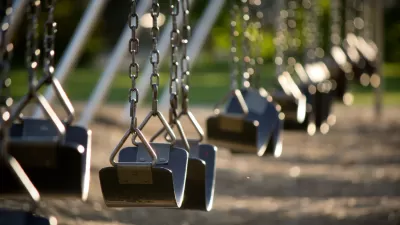A recent Planetizen interview on the relationship between park space and active living got me thinking about what spaces inspire physical activity and what spaces discourage it. In my old apartment complex, the indoor fitness centers were jammed while the nearby riverside walking trails were desolate, despite nearly perfect year-round weather. Why? The trails were perceived as unsafe because they were completely isolated from view.
A recent Planetizen interview on the relationship between park space and active living got me thinking about what spaces inspire physical activity and what spaces discourage it.
In my old apartment complex, the indoor fitness centers were jammed
while the nearby riverside walking trails were desolate, despite nearly
perfect year-round weather. Why? The trails were perceived as unsafe
because they were completely isolated from view.
 I'm somewhat perplexed by the trend in trail building: rail trails,
I'm somewhat perplexed by the trend in trail building: rail trails,
urban greenways, trails through state parks, trails through the woods
and backcountry. These may be ideal for bicyclists or for weekend
hikes with friends. But they are not practical places for solo walkers
and joggers.
Greenways, trails and ill-defined open spaces often don't work as
envisioned because planners fail to consider safety as a paramount
issue, especially for women. Even if crime statistics declare an area safe, it's really the perceived safety that counts. I am simply not
going to step onto a secluded trail (unless, perhaps, it has constant
foot traffic).
 The wilderness-like parks seem to be
The wilderness-like parks seem to be
increasingly emphasized at the expense of smaller community parks that
provide the right facilities for outdoor exercise. One element
overlooked by park planners is the community track or paved walking
loop. In the eastern US, many high school tracks are open to the
public; they tend to be safe and well-used. Out West, school tracks are
unfortunately locked and reserved for student use only. Where school
tracks are not an option, walking loops within parks are a good
alternative. These can be placed around baseball diamonds, soccer
fields, playgrounds and picnic areas.
Because park safety depends largely on visibility, walking loops should
be within the sightline of other park users as well as passersby.
Ideally, the park would offer a diversity of activities that attract
visitors. It would also be large enough for physical activity but not
so expansive that people feel lost.
I'm curious to hear from Planetizen readers about local parks that
encourage active living. What about trails and greenways? Which seem
to be heavily used for recreation and/or transportation? What makes
them work?
Photos:
1) Rail Trail in CT (adwriter/Flickr)
2) Jackson Square, New Orleans (KenSBrown/Flickr)

Alabama: Trump Terminates Settlements for Black Communities Harmed By Raw Sewage
Trump deemed the landmark civil rights agreement “illegal DEI and environmental justice policy.”

Study: Maui’s Plan to Convert Vacation Rentals to Long-Term Housing Could Cause Nearly $1 Billion Economic Loss
The plan would reduce visitor accommodation by 25% resulting in 1,900 jobs lost.

Why Should We Subsidize Public Transportation?
Many public transit agencies face financial stress due to rising costs, declining fare revenue, and declining subsidies. Transit advocates must provide a strong business case for increasing public transit funding.

Wind Energy on the Rise Despite Federal Policy Reversal
The Trump administration is revoking federal support for renewable energy, but demand for new projects continues unabated.

Passengers Flock to Caltrain After Electrification
The new electric trains are running faster and more reliably, leading to strong ridership growth on the Bay Area rail system.

Texas Churches Rally Behind ‘Yes in God’s Back Yard’ Legislation
Religious leaders want the state to reduce zoning regulations to streamline leasing church-owned land to housing developers.
Urban Design for Planners 1: Software Tools
This six-course series explores essential urban design concepts using open source software and equips planners with the tools they need to participate fully in the urban design process.
Planning for Universal Design
Learn the tools for implementing Universal Design in planning regulations.
Caltrans
Smith Gee Studio
Institute for Housing and Urban Development Studies (IHS)
City of Grandview
Harvard GSD Executive Education
Toledo-Lucas County Plan Commissions
Salt Lake City
NYU Wagner Graduate School of Public Service




























